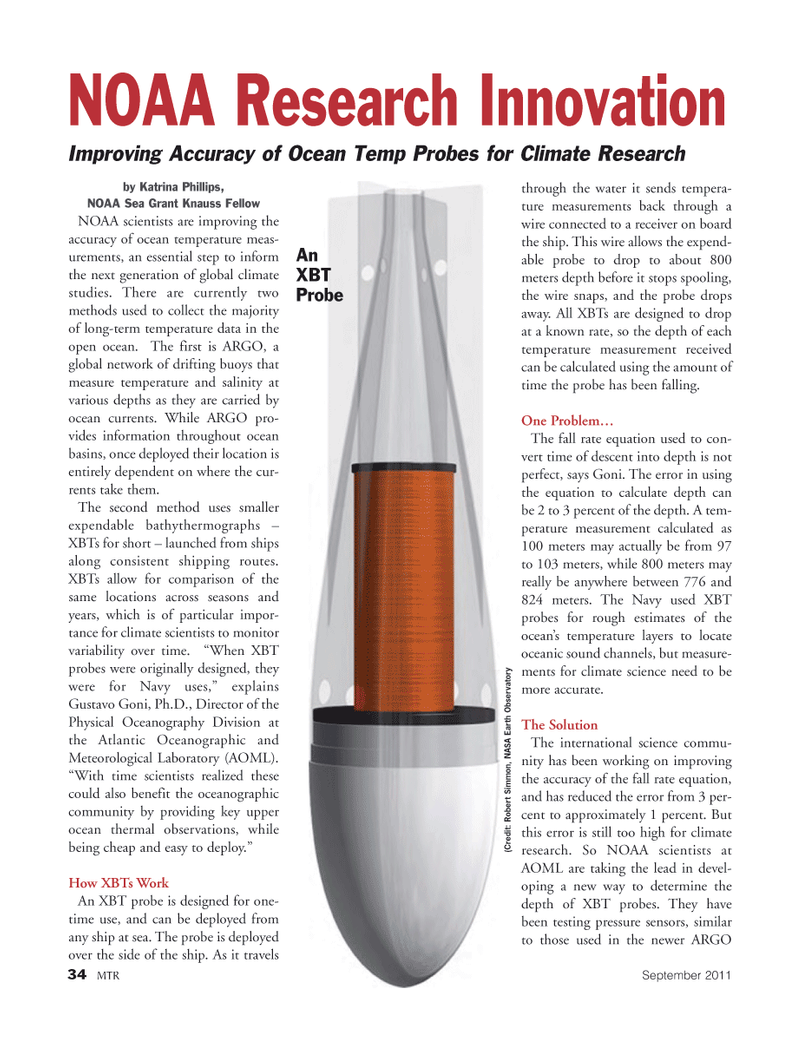
Page 34: of Marine Technology Magazine (September 2011)
Ocean Observation
Read this page in Pdf, Flash or Html5 edition of September 2011 Marine Technology Magazine
by Katrina Phillips, NOAA Sea Grant Knauss FellowNOAA scientists are improving the accuracy of ocean temperature meas- urements, an essential step to inform the next generation of global climatestudies. There are currently two methods used to collect the majorityof long-term temperature data in the open ocean. The first is ARGO, a global network of drifting buoys that measure temperature and salinity at various depths as they are carried by ocean currents. While ARGO pro- vides information throughout ocean basins, once deployed their location is entirely dependent on where the cur- rents take them. The second method uses smallerexpendable bathythermographs ?XBTs for short ? launched from ships along consistent shipping routes. XBTs allow for comparison of the same locations across seasons and years, which is of particular impor- tance for climate scientists to monitorvariability over time. ?When XBT probes were originally designed, they were for Navy uses,? explains Gustavo Goni, Ph.D., Director of the Physical Oceanography Division at the Atlantic Oceanographic and Meteorological Laboratory (AOML). ?With time scientists realized these could also benefit the oceanographiccommunity by providing key upper ocean thermal observations, while being cheap and easy to deploy.? How XBTs Work An XBT probe is designed for one- time use, and can be deployed from any ship at sea. The probe is deployed over the side of the ship. As it travels through the water it sends tempera- ture measurements back through a wire connected to a receiver on board the ship. This wire allows the expend- able probe to drop to about 800 meters depth before it stops spooling, the wire snaps, and the probe drops away. All XBTs are designed to drop at a known rate, so the depth of each temperature measurement received can be calculated using the amount oftime the probe has been falling. One Problem? The fall rate equation used to con-vert time of descent into depth is not perfect, says Goni. The error in using the equation to calculate depth canbe 2 to 3 percent of the depth. A tem- perature measurement calculated as 100 meters may actually be from 97 to 103 meters, while 800 meters mayreally be anywhere between 776 and 824 meters. The Navy used XBT probes for rough estimates of the ocean?s temperature layers to locate oceanic sound channels, but measure- ments for climate science need to bemore accurate. The Solution The international science commu-nity has been working on improving the accuracy of the fall rate equation,and has reduced the error from 3 per- cent to approximately 1 percent. But this error is still too high for climate research. So NOAA scientists at AOML are taking the lead in devel- oping a new way to determine the depth of XBT probes. They have been testing pressure sensors, similar to those used in the newer ARGO NOAA Research Innovation Improving Accuracy of Ocean Temp Probes for Climate ResearchAn XBT Probe (Credit: Robert Simmon, NASA Earth Observatory 34MTRSeptember2011 MTR#7 (34-48):MTR Layouts 8/29/2011 10:15 AM Page 34

 33
33

 35
35
